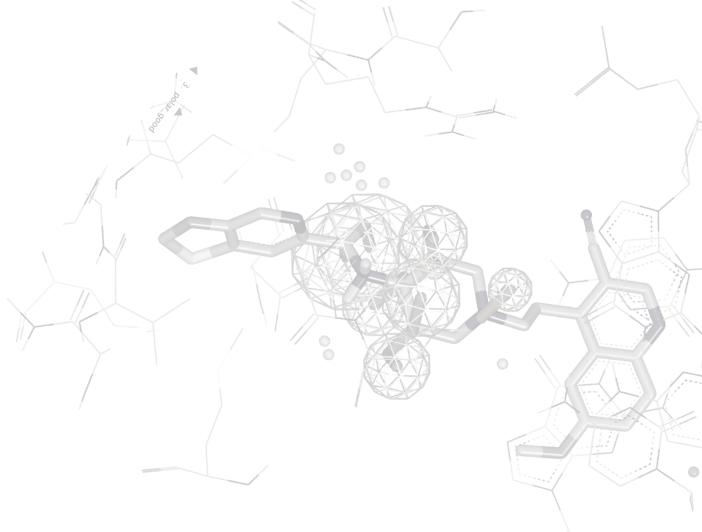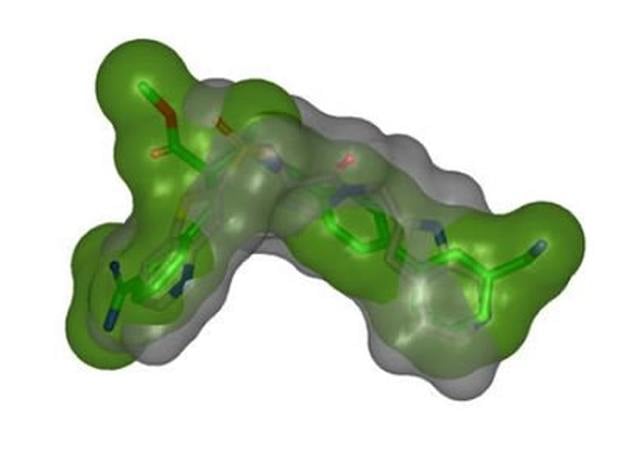
Shape TK
Shape TK is the basis for the ROCS® application for shape-based similarity searching. The toolkit allows for fine control over optimization methods, molecule treatment and the nature of the query (grids, generic shapes). Shape TK facilitates the calculation of molecular descriptors for shape (steric multipoles), volume overlap between molecules, and spatial similarity of chemical groups (color force field), as well as the optimization of the latter two quantities.
Examples of use include real-space fitting to electron density, shape fingerprinting [1], discrimination between agonists and antagonists based on shared shapes [2], generation of composite queries from solvent mapping [3], and aligning and comparing protein active sites [4].
For more detailed information on Shape TK, check out the link below:
Documentation
Modeling
The Modeling suite of toolkits provides the core functionality underlying OpenEye's defining principle that shape & electrostatics are the two fundamental descriptors determining intermolecular interactions. Many of the toolkits in the Modeling suite are directly associated with specific OpenEye applications and can, therefore, be used to create new or extend existing functionality associated with those applications.
- OEChem TK Core chemistry handling and representation as well as molecule file I/O
- FastROCS™ TK Real-time shape similarity for virtual screening, lead hopping & shape clustering
- OEDocking TK Molecular docking and scoring
- Omega TK Conformer generation
- Shape TK 3D shape description, optimization, and overlap
- SiteHopper TK Rapid Comparison of Protein Binding Sites
- Spicoli TK Surface generation, manipulation, and interrogation
- Spruce TK Protein preparation and modeling
- Szybki TK General purpose optimization with MMFF94
- Szmap TK Understanding water interactions in a binding site
- Zap TK Calculate Poisson-Boltzmann electrostatic potentials
Cheminformatics
The Cheminformatics suite of toolkits provides the core foundation upon which all the OpenEye applications and remaining toolkits are built.
- OEChem TK Core chemistry handling and representation as well as molecule file I/O
- OEDepict TK 2D Molecule rendering and depiction
- Grapheme™ TK Advanced molecule rendering and report generation
- GraphSim TK 2D molecular similarity (e.g. fingerprints)
- Lexichem TK name-to-structure, structure-to-name, foreign language translation
- MolProp TK Molecular property calculation and filtering
- Quacpac TK Tautomer enumeration and charge assignment
- MedChem TK Matched molecular pair analysis, fragmentation utilities, and molecular complexity metrics
References
- Small molecule shape-fingerprints Haigh, J. A., Pickup, B. T., Grant, J. A., Nicholls, A., J. Chem. Inf. Model., 2005, 45, 673.
- Scaffold hopping, synthesis and structure-activity relationships of 5,6-diaryl-pyrazine-2-amide derivatives: a novel series of CB1 receptor antagonists Boström, J., Berggren, K., Elebring, T., Greasley, P.J., Wilstermann, M., Bioorg Med Chem., 2007, 15, 4077.
-
The use of fake ligands from computational solvent mapping in ligand and structure-based virtual screening Hall, D. R., Enyedy, I.
- SiteHopper - a unique tool for binding site comparison
Over 800x Speed-Up on Orion to Enable Rapid and Reliable Drug Design
Expanding Orion’s Capabilities with AI
miniWebinar | Shape and color: A unifying principle for modeling molecules
miniWebinar: Faster, Larger, Smarter: Filling the Funnel for Ultra-Large Scale Virtual Screening
Resources
Glimpse the Future through News, Events, Webinars and more
Webinar
miniWebinar: Opening up the druggable universe one cryptic pocket at a time
News
Over 800x Speed-Up on Orion to Enable Rapid and Reliable Drug Design


